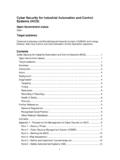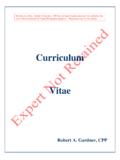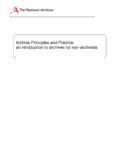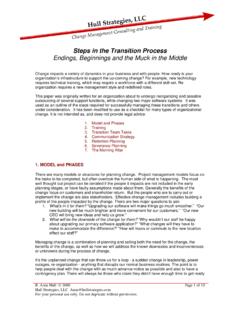Transcription of Mastering operational risk - John Thirlwell
1 Mastering operational risk John Thirlwell IRM operational Risk SIG. 2 December 2010. Writing the book What's so special about operational risk? The operational risk framework Governance Losses and measurement operational risk appetite The benefits of getting it right People risk operational risk: How to break it down? The Framework; putting the Framework to work History; the Framework, putting the Framework to work History; the Framework, putting the Framework to work; business case;. mitigation Breaking it down Part 1: Setting the scene What is operational risk? The business case Part 2: The Framework Governance, RCA, Events and losses, indicators Part 3: Advancing the Framework Reporting, modelling, scenarios and stress testing Part 4: Mitigation and assurance Business continuity, insurance, internal audit Part 5: Practical operational risk management Outsourcing, people risk, reputation risk ORM Framework Governance Key indicators Risk & Control Assessment Losses Identify Specify Identify risk Identify control Identify and Analyse risk and risk and owner and owner capture loss control appetite Assess Assess design internal and causes indicators likelihood and and external impact performance losses Action plans Action plans Action plans Scenarios and Modelling Reporting Writing the book What's so special about operational risk?
2 The operational risk framework Governance Losses and measurement operational risk appetite The benefits of getting it right People risk Defining operational risk operational risk is the risk of direct or indirect losses resulting from inadequate or failed processes, people or systems, or from external events.' [ operational risk: the next frontier. RMA/PriceWaterhouseCoopers, 1999]. The risk of loss resulting from inadequate or failed internal processes, people or systems or from external events' [Basel II]. - includes legal risk; excludes strategic and reputational risk - regulatory risk? The risk of loss arising from inadequate or failed internal processes, or from personnel and systems, or from external events.' [Solvency II]. Is operational risk different from other risks ? Credit, market, operational commodity, liquidity Is the risk transaction-based?
3 Is the risk assumed proactively ? Can it be identified from accounting information the P&L? Can audit confirm that every occurrence of the risk has been captured? Can its financial impact be capped or limited? Can you trade the risk? Is everybody in the firm responsible for the risk? Does the risk affect every activity? operational Risk (including Strategic Risk). An attempt to frame the unframeable, to assuage fears about the uncontrollable rogue others' and to tame the man-made monsters [of the financial system]. Prof Michael Power, Organized uncertainty : designing a world of risk management (OUP, 2007). The world has never been so full of risk'. (Thomas Aquinas, 1245). National security strategy (Oct 2010). TIER 1 TIER 2. International terrorism Chemical, biological, nuclear, radioactive (CBNR) weapons Cyber attacks and large scale Overseas insurgency creating cyber crime environment for terrorism Major accident or natural hazard, Organised crime extensive coastal flooding, pandemic International military crisis Satellite communications disrupted Writing the book What's so special about operational risk?
4 The operational risk framework Governance Losses and measurement operational risk appetite The benefits of getting it right People risk ORM Framework Governance Key indicators Risk & Control Assessment Losses Identify Specify Identify risk Identify control Identify and Analyse risk and risk and owner and owner capture loss control appetite Assess Assess design internal and causes indicators likelihood and and external impact performance losses Action plans Action plans Action plans Scenarios and Modelling Reporting The 3 lines of defence B O A R D. Risk Committee Audit Committee RISK RISK RISK. OWNERS OVERSIGHT ASSURANCE. Business Eg: Risk, Internal and operations compliance, external audit legal, health &. safety, IT. security, etc Board Leadership Culture Tone from the top / tune in the middle Strategy and objectives Appetite Reporting and communication ORM Framework Governance Key indicators Risk & Control Assessment Losses Identify Specify Identify risk Identify control Identify and Analyse risk and risk and owner and owner capture loss control appetite Assess Assess design internal and causes indicators likelihood and and external impact performance losses Action plans Action plans Action plans Scenarios and Modelling Reporting Board Leadership Culture Tone from the top / tune in the middle Strategy and objectives Appetite Reporting and communication Risk, the Risk function and Risk Committee Where does the operational risk function sit?
5 B O A R D. Risk Committee Audit Committee RISK RISK RISK. OWNERS OVERSIGHT ASSURANCE. Business Eg: Risk, HR, Internal and operations compliance, external audit legal, health &. safety, IT. security, etc Risk assurance Independent Internal audit Objectives Status and position in the firm Audit Committee Priorities External audit financial reporting Internal audit as consultant Internal audit as investigator ORM Framework Governance Key indicators Risk & Control Assessment Losses Identify Specify Identify risk Identify control Identify and Analyse risk and risk and owner and owner capture loss control appetite Assess Assess design internal and causes indicators likelihood and and external impact performance losses Action plans Action plans Action plans Scenarios and Modelling Reporting The risk register or What needs to go right? Issues and decisions concerning event data Which events?
6 Reporting threshold Near misses Boundary losses Gains The data Amount (the basis of severity). Date (the basis of frequency). Loss category Realities of risk event data It will be incomplete, scarce and patchy, even allowing for external data the tail' problem. Lognormal and bimodal distributions Realities of risk event data It will be incomplete, scarce and patchy, even allowing for external data the tail' problem. It will be inconsistently reported although, once reported, it is auditable. It is historic and backward looking. Major events will probably have led to tighter controls, change of policy etc. The external environment will change. However It can validate indicators, risk and control assessments and scenarios It is the beginning of the essential chain of: Data information knowledge understanding BUT THAT ONLY COMES WITH.
7 Felix qui potuit rerum cognoscere causas (Vergil, Georgics). Felix qui potuit rerum cognoscere causas (Vergil, Georgics). It is the cause, it is the cause, my soul. (Shakespeare, Othello). Felix qui potuit rerum cognoscere causas (Vergil, Georgics). It is the cause, it is the cause, my soul. (Shakespeare, Othello). CAUSE EVENT EFFECT. A Typical Crisis Model Organisational Cultural and Design Human and Structure Factors Trigger Event Loss Economic and Strategic Imperatives Dr Simon Ashby, The 6 C's of the financial crisis, (Financial Services Research Forum, Nottingham University Business School: April 2010). Unlike the position that exists in the physical sciences, in economics and other disciplines that deal with essentially complex phenomena, the aspects of the events to be accounted for about which we can get quantitative data are necessarily limited and may not include the important ones.
8 Friedrich von Hayek, Pretence of Knowledge, Nobel acceptance speech 1974. Our knowledge of the way things work, in society or in nature, comes trailing clouds of vagueness. Vast ills have followed belief in certainty. Kenneth Arrow, I know a hawk from a handsaw (CUP 1992). ORM Framework Governance Key indicators Risk & Control Assessment Losses Identify Specify Identify risk Identify control Identify and Analyse risk and risk and owner and owner capture loss control appetite Assess Assess design internal and causes indicators likelihood and and external impact performance losses Action plans Action plans Action plans Scenarios and Modelling Reporting Modelling operational risk - a qualitative approach Use existing risk and control assessments No need to wait for adequate loss history How it might work: Set up ranges Assess impact and likelihood of risks Assess failure probabilities of controls Correlate risks (if possible).
9 Challenge input Run Monte Carlo simulations Assimilate results and reports Writing the book What's so special about operational risk? The operational risk framework Governance Losses and measurement operational risk appetite The benefits of getting it right People risk operational risk appetite Risk of loss a firm is willing to accept for a given risk-reward ratio [over a specified time horizon at a given level of confidence]. Some examples No/minimal appetite for losses arising from financial crime, reputation, legal, regulatory events Unmitigated losses no more than x% of PBT in any 3- year period No individual OR losses above x or cumulative losses above y over 12 month period. Losses above z to be reported to Risk or Audit Committees. But do these mean anything in the world of op risk? Whose appetite is it anyway? Risk appetite some principles Requires well-defined business objectives and well-defined objectives of appetite Should inform business decisions Will be defined in quantitative and qualitative terms; requires multi-criteria components Tied in to business performance and reward Risk appetite in relation to loss experience Risk appetite using risk assessment scores (1).
10 Annual Loss Thresholds Low 25,000. Acceptable 100,000. Warning 450,000. Catastrophic 1,500,000. Impact per event ( ). L'bound U'bound Mid point Low 0 50,000 25,000. Med-low 50,000 150,000 100,000. Med-high 150,000 500,000 325,000. High 500,000 1,500,000 1,000,000. Likelihood of event (per annum). L'bound U'bound Alternative label Mid point Low 10% likely in next year Med-low 30% likely in next year Med-high Very likely in next year High Several times in next year Risk appetite using risk assessment scores (2). High 70,000 220,000 670,000 6,500,000. Med-high 22,750 71,500 217,750 2,112,500. IMPACT. Med-low 7,000 22,000 67,000 650,000. Low 1,750 5,500 16,750 162,500. 10% likely 30% likely Very likely Severe LIKELIHOOD. Optimising resource through risk and control assessments Risk appetite using Key Risk Indicator thresholds for Number of help desk queries'.





